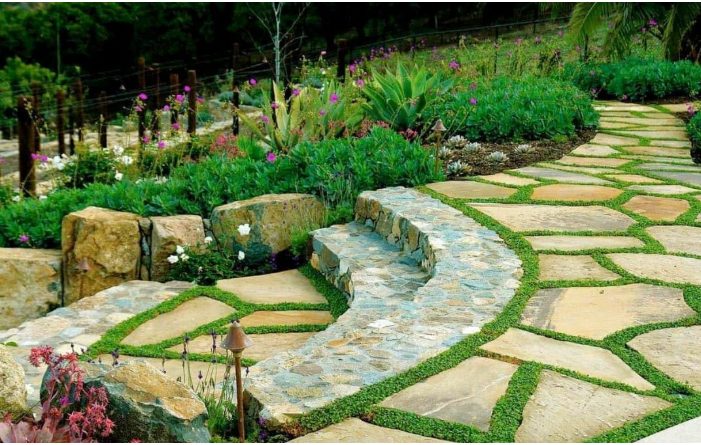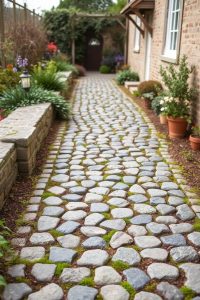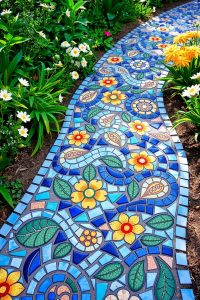
10 Creative Garden Pathway Ideas to Beautify Your Outdoor Space

A beautiful garden deserves a path that invites you to explore. A well-designed garden pathway doesn’t just connect areas—it adds charm, style, and function.
Every step on the path should feel like part of the journey, not just a way to get from point A to B.
That’s why garden pathways matter just as much as the flowers, plants, or decorations in your yard.
Paths help guide guests, protect your lawn, and define the layout of your outdoor space. The materials, shapes, and patterns you pick can give your garden a peaceful,
playful, or elegant look. Stepping stones tucked between plants feel natural and calm. Brick or gravel paths add texture and structure. Straight paths bring order.
Curved ones add flow and mystery. Even a narrow walkway can become a standout feature with the right design.
Not every garden needs a fancy or costly walkway. Creative choices with wood, pebbles, or recycled materials can make a big visual impact without breaking the budget.
A pathway made from log slices can give a rustic vibe. Smooth river rocks placed with care can add a Zen-like feel.
Think of your path as a part of the garden’s personality. Whether you like clean modern lines or soft cottage charm, there’s a design that matches your taste.
Well-placed lighting, edges, and plants along the path can take the look even further. Border plants such as lavender or boxwood offer both beauty and structure.
Solar lights keep the path safe and cozy after dark. Even mismatched or asymmetrical paths can feel intentional and stylish with the right touch.
This list of ten garden pathway ideas includes simple, elegant, and bold options. Each one offers a way to make your yard more inviting and personal.
These ideas can spark your creativity and help you plan a path that’s not just practical—but also a joy to walk on.
Let’s explore how a few stones, steps, or bricks can lead to something truly beautiful.
10 Garden Pathways Ideas
1. Gravel Pathway with Stone Edging

Gravel paths are simple to build and easy to maintain. They drain water well and work in all kinds of weather. You can walk on them after rain without making a mess.
Gravel looks clean and fits well in natural or modern gardens. Use small stones like pea gravel for a soft feel. Pick a color that matches your plants and home.
Gray, white, or tan work in most yards. Add edging to keep gravel in place. Use bricks, metal, or stone borders.
This also keeps grass from growing into the path. Keep the gravel thick enough to cover the soil but not too deep. A weed barrier under the gravel helps stop weeds.
Line the path with low plants, lanterns, or flower pots. This adds color and makes the path stand out. You can also shape the path as straight, curved, or zigzag.
2. Stepping Stone Path in Grass
A stepping stone path looks soft and peaceful. Place large flat stones in a line across the grass. Leave space between them. Let grass grow around each stone.
This blends the path into the lawn. Use natural stones with flat tops. Make sure they sit level with the ground. That way, they’re easy to walk on and safe.
This type of path is great for light foot traffic. You can use it to reach a bench, a shed, or a garden bed.
You don’t need to dig too deep. Just remove the grass under each stone. Then level the soil and place the stone. It takes little time and looks natural.
You can also mix in clover or moss between the stones for a soft touch. This path works well in open lawns and small gardens.
3. Brick Garden Path

Brick paths bring a classic and warm look. You can use old bricks for a rustic style or new bricks for a clean finish. Bricks come in red, brown, or gray shades.
Match them with your house or garden fence. Lay bricks in rows or in fun patterns like herringbone or basket weave. Patterns make the path look more detailed.
Use sand or gravel between the bricks to keep them firm. A firm base stops bricks from sinking.
Brick paths work well near flower beds or patios. They look tidy and last many years. Add plants or flowers along the edge to soften the strong lines.
Seal the bricks if you want less water damage. This also helps prevent moss. Bricks are easy to clean. A quick sweep or wash keeps the path fresh.
4. Wood Slice Pathway
Wood slice paths look natural and rustic. Cut tree trunks into round pieces about 2 inches thick. Lay them flat into the soil or gravel.
Keep them close or leave space in between. Use hardwoods like oak or maple. These last longer and stay firm.
You can treat the wood with sealant to protect it from water. Place the slices on a sand base to keep them level.
Fill the gaps with mulch, gravel, or moss. This adds texture and keeps weeds down. Wood slice paths are perfect for forest gardens or wild spaces.
They look soft and blend with trees and ferns. This path works well in shady areas. Avoid very wet places where wood may rot. Replace damaged slices over time.
5. Concrete Slab Path

Concrete slabs make bold and clean paths. Use square or rectangle shapes for a modern look. Leave space between each slab for grass or gravel.
This makes the path feel lighter. Set the slabs on sand or gravel for support. Make sure each one is level and firm. Space them evenly for a neat look.
You can choose plain gray or colored slabs. Some even have textures or patterns. This type of path suits modern homes.
It also works well with neat gardens and straight lines. Add small lights or plants near the edges to soften the design.
Concrete slabs last long and handle heavy use. They stay firm in rain or sun. Sweep them often to keep clean. You can also wash them with water if needed.
6. Cobblestone Pathway

Cobblestone paths feel strong and full of history. They use small round or square stones. Each one has a different size and shape. The uneven look gives charm.
Set cobblestones in sand or mortar. You can lay them close for a solid path. Or leave space and fill gaps with moss or small plants.
These paths look great in cottage gardens or old-style homes. Cobblestones last many years. They can handle water and snow well.
They work best for short paths or small areas. Use edging to keep the stones from spreading.
The rough surface may not suit strollers or bikes. But for foot paths, they add beauty. Sweep often to clear leaves and dirt.
7. Mulch Garden Path
Mulch paths feel soft and smell fresh. Use bark chips, shredded wood, or pine needles. These cover the soil and stop weeds. They also help the soil hold water.
Lay the mulch 2–3 inches deep. Put a weed barrier or cardboard under it first. This keeps weeds down and mulch clean. Edge the path with logs, bricks, or metal strips.
Mulch paths suit veggie gardens, flower beds, or shady corners. They break down over time, feeding the soil. Add new mulch each year to keep it tidy.
You can walk on mulch paths with bare feet. They feel soft and quiet. They’re great for kids or pets too.
8. Tile or Mosaic Pathway

Tile paths add color and fun. Use bright tiles, broken plates, or ceramic pieces. Mix colors to form shapes or pictures. Set the pieces in concrete or mortar to stay firm.
You can make flowers, stars, or waves. Or just random patterns. These paths bring art to your garden. They work well in small spaces or near patios.
Use strong tiles that don’t crack in heat or cold. Seal the surface to protect colors. Mosaic paths need care but give a special look.
This idea fits playful gardens or art spaces. Make one path or just a circle near a bench. It draws the eye and makes people smile.
9. Flagstone Garden Path
Flagstone paths look wide and calm. Use big flat stones in natural shapes. Lay them like puzzle pieces. You can leave space between or place them tight.
Set the stones on sand or gravel. Fill gaps with moss, dirt, or small plants. Flagstone paths match wild gardens, herb beds, or patios.
Choose gray, tan, or blue stones. These colors blend with nature. Flagstones feel strong underfoot. They don’t move if placed right.
Add soft lights or ground cover around the edges. This makes the space feel open. Keep the stones clean with a broom or water.
10. Grass Path with Stone Borders

Grass paths feel fresh and green. Let the grass grow thick in the middle. Line the edges with bricks, rocks, or metal. This keeps the path clear and neat.
Mow the grass often to keep it short. Trim the edges for a clean look. Grass paths work in open yards or light-use areas.
They connect garden beds without breaking the natural flow.
Use stepping stones in wet areas to stop mud. Grass paths need sun and care, but they stay soft and cool.
Add flower borders or shrubs on the sides. This makes the path feel like part of the garden.
FAQs
Which garden path lasts the longest?
Cobblestone and concrete paths last the longest. They hold shape for years and resist damage.
What path is easiest to build?
Gravel or mulch paths are easiest. No hard tools needed. Just shape and fill.
How wide should a garden path be?
One person needs 2–3 feet. Two people side by side need 4–5 feet.
Do I need to dig deep for a path?
Most paths need 2–4 inches. For stone or brick, dig 6 inches and add a base.
Can I mix path styles?
Yes. Use bricks near patios, gravel for curves, and wood in forest areas.
Conclusion
Garden paths do more than lead the way. They shape the garden and add charm. Each step shows care and thought.
These 10 ideas work in big or small gardens. Some feel soft. Some look bold. All bring something special. Pick what suits your space and start building.
Your garden path tells a story. Let each step say something beautiful.
